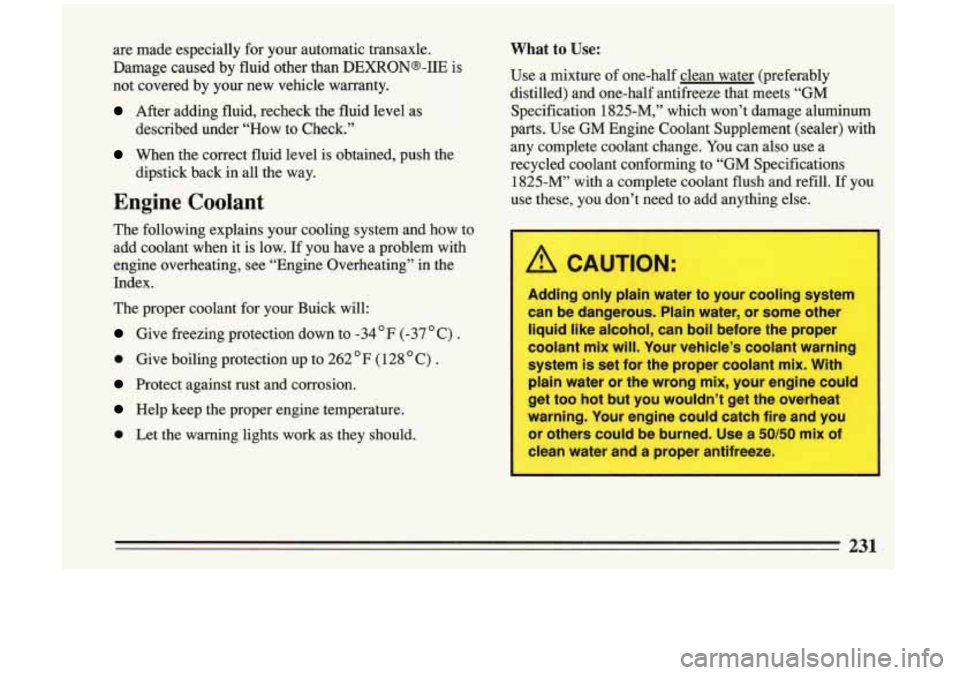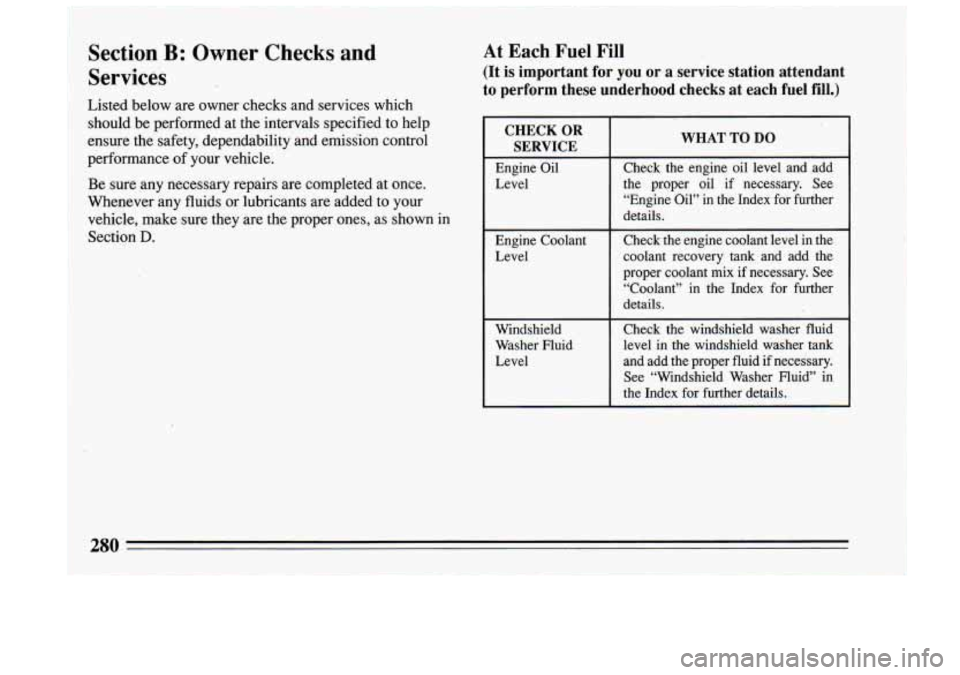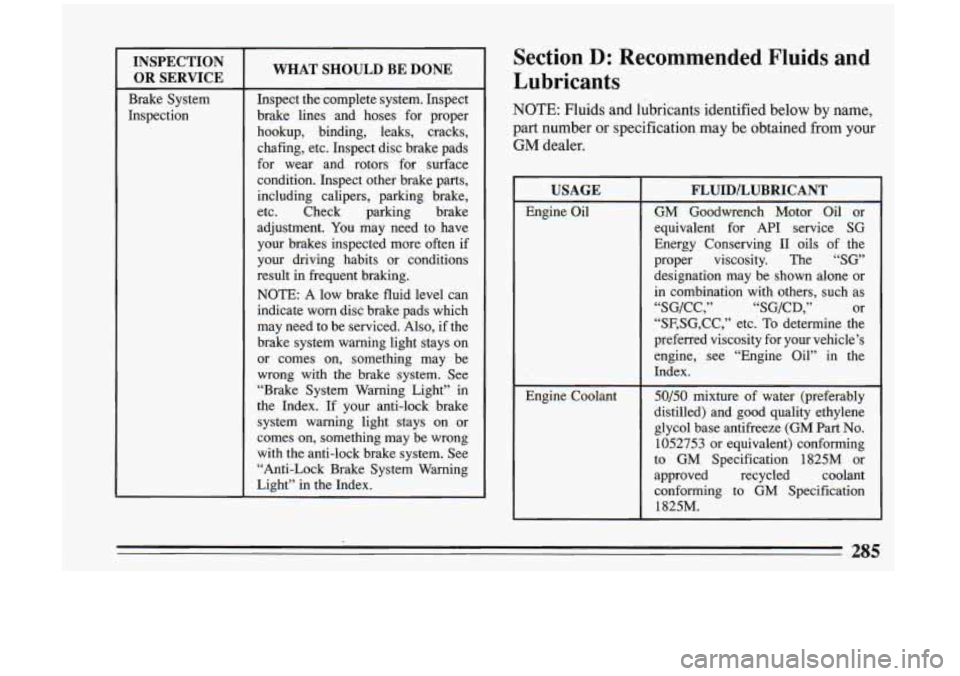Page 205 of 324
1
4. Then fill the coolant recovery tank to “FULL
COLD.’3
6. Start the engine and let it run until you can feel the
upper radiator hose getting hot. Watch out forthe
-
5. Put the cap back on the coolant recovery tank, but engine fan.
filler neck may be lower. If the level is lower, add
more of the proper mix through the filler neck until
the level reaches the base of the filler neck.
leave the
radiator pressure cap
off. 7. By this time the coolant level inside the radiator
203
Page 225 of 324
A CAUTION:
An electric fan under the hood can start up and
injure you even when the engine is not running.
Keep hands, clothing and tools away from a---
underhood electric fan.
-
A CAUTION:
Things that burn can get on hot engine parts
and start a fire. These include liquids like
gasoline,
oil, coolant, brake fluid, windshield
washer and other fluids, and plastic or rubber.
You or others could be burned. Be careful not to
drop or spill things that will burn onto a hot
engine.
Before closing the hood, be sure all the filler caps are on
properly.
Then just pull the hood down and close
it firmly.
Page 233 of 324

are made especially for your automatic transaxle.
Damage caused by fluid other than
DEXRONs-IIE is
not covered by your new vehicle warranty.
After adding fluid, recheck the fluid level as
described under
“How to Check.”
When the correct fluid level is obtained, push the
dipstick back in all the way.
Engine Coolant
The following explains your cooling system and how to
add coolant when it is low. If you have a problem with
engine overheating, see “Engine Overheating” in the
Index.
The proper coolant for your Buick
will:
Give freezing protection down to -34’F (-37 ’ C) .
0 Give boiling protection up to 262 ’ F ( 128 ’ C) .
Protect against rust and corrosion.
Help keep the proper engine temperature.
0 Let the warning lights work as they should.
What to Use:
Use a mixture of one-half clean water (preferably
distilled) and one-half antifreeze that meets “GM Specification 1825-M,” which won’t damage aluminum
parts. Use GM Engine Coolant Supplement (sealer) with
any complete coolant change. You can also use a
recycled coolant conforming to “GM Specifications
1825-M” with a complete coolant flush and-refill.
If you
use these, you don’t need to add anything else.
Adding only plain water to your cooling system
can be dangerous. Plain water, or some other
liquid like alcohol, can boil before the proper
coolant mix will. Your vehicle’s coolant warnin!
system
is set for the proper coolant mix. With
plain water or the wrong mix, your engine coul
get
too hot but you wouldn’t get the overheat
warning. Your engine could catch fire and you
or others could be burned. Use a
50150 mix of
clean water and
a proper antifreeze.
231
Page 234 of 324
Adding Coolant
The engine coolant
recovery tank is located at
the left
of the engine
compartment.
To Check Coolant: When
your engine is cold, the
coolant level should be at
“FULL COLD,” or a little
higher. When your engine
is
warm, the level should be
up to
“FULL HOT,” or a
little higher.
To Add Coolant: If you need more coolant, add the
proper mix at the coolant recovery
tank.
232
Page 235 of 324
A CAUTION:
Turning the radiator pressure cap when the
engine and radiator are hot can
allow steam and
scalding liquids to blow out and burn you badly.
With the coolant recovery tank, you
will almost
never have to add coolant at the radiator. Never
turn the radiator pressure cap
-- even a little --
when the engine and radiator are hot.
Add coolant mix at the recovery tank, but be careful not
to spill it.
A CAUTION:
You can be burned if you spill coolant on hot
engine parts. Coolant contains ethylene glycol,
and it
will burn if the engine parts are hot
enough. Don’t spill coolant on a hot engine.
Radiator Pressure Cap
When you replace your radiator pressure cap, an ACS
cap
is recommended.
Thermostat
Engine coolant temperature is controlled by a thermostat
in the engine coolant system. The thermostat stops ,the
flow of coolant through the radiator until the coolant
reaches a preset temperature.
When you replace your thermostat, an AC@ thermostat
is recommended. I
233
Page 265 of 324
Fuse Usage
(Fuse Block - Lower Left Side of Console)
Amp Description
1.
2.
3.
4.
5.
6.
7.
8.
9.
10.
11.
12.
13.
14.
15.
16.
17.
18.
19.
20.
10
20
10
20
10
20
15
3
10
20
15
25
10
15
25
3
20
10
20
5
ISO-IGN
Body
Antenna
Cigar
BCM/IPC Stopmazard
Turn Signal
Cruise
WAC
Park Light
Radio
1
Wiper
Radio
2
SIR
BoseO
Crank
Trunk-rel/Pull
Down & Fuel Door Re1
AIC
Elc Compressor
Coolant Fan
There is also a fuse block that is located on the right side
of the console under a carpeted panel cover. Remove the
cover to access these fuses.
263
Page 282 of 324

.Section B: Owner Checks and
Services At Each Fuel Fill
(It is important for you or a service station attendant
to perform these underhood checks at each fuel
fill.)
Listed below are owner checks and services which
should be performed at the intervals specified to help
ensure the safety, dependability and emission control
performance of your vehicle.
Be sure any necessary repairs are completed at once.
Whenever any fluids or lubricants are added to your
vehicle, make sure they are the proper ones, as shown in
Section
D.
CHECK OR
SERVICE
Engine Oil
Level
Engine Coolant
Level
Windshield
Washer Fluid
Level
WHAT TO DO
Check the engine oil level and add
the proper oil if necessary. See “Engine Oil” in the Index for further
details.
Check the engine coolant level in the
coolant recovery tank and add the
proper coolant mix if necessary. See “Coolant” in the Index for further
details.
Check the windshield washer fluid
level in the windshield washer tank
and add the proper fluid if necessary.
See “Windshield Washer Nuid”
in
the Index for further details. ~-~ ~- ~
280 .~
Page 287 of 324

INSPECTION OR SERVICE
Brake System
Inspection
WHAT SHOULD BE DONE
Inspect the complete system. Inspect
brake lines and hoses for proper
hookup, binding, leaks, cracks,
chafing, etc. Inspect disc brake pads
for wear and rotors for surface
condition. Inspect other brake parts, including calipers, parking brake,
etc. Check parking brake
adjustment. You may need to have
your brakes inspected more often if
your driving habits or conditions
result in frequent braking.
NOTE: A low brake fluid level can
indicate worn disc brake pads which
may need to be serviced. Also, if the
brake system warning light stays on
or comes on, something may be
wrong with the brake system. See
“Brake System Warning Light” in
the Index. If your anti-lock brake
system warning light stays on or
comes
-on, something may be wrong
with the anti-lock brake system. See “Anti-Lock Brake System Warning
Light” in the Index.
Section D: Recommended Fluids and
Lubricants
NOTE: Fluids and lubricants identified below by name,
part number or specification may be obtained from your
GM dealer.
USAGE
Engine Oil
Engine Coolant
FLUID/LUBRICANT
GM Goodwrench Motor Oil or
equivalent for API service SG
Energy Conserving
I1 oils of the
proper viscosity. The
“SG’
designation may be shown alone or
in combination with others, such as
“SG/CC,” “SG/CD,” or
“SF,SG,CC,” etc. To determine the
preferred viscosity for your vehicle’s
engine, see “Engine Oil” in the
Index.
50/50 mixture of water (preferably
distilled) and good quality ethylene
glycol base antifreeze
(GM Part No.
1052753 or equivalent) conforming
to GM Specification 1825M
or
approved recycled coolant
conforming to GM Specification
1825M.
285